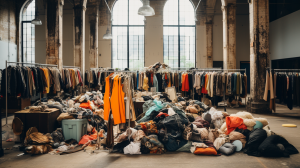
Catwalk Conundrum: India’s High Fashion Tangles with the Green Thread of Sustainability
In the heart of India’s glittering fashion cosmos, a seismic shift rumbled through the prestigious Lakmé Fashion Week last month. The event, a dazzling fusion of billionaire Mukesh Ambani’s Reliance Brands, the esteemed Fashion Design Council of India (FDCI), and beauty behemoth Lakmé, morphed into more than just a showcase of sartorial splendor. It became a battleground where the swords of sustainability clashed with the shields of style.
Beneath the shimmering lights and the hypnotic allure of the catwalks, a deeper narrative unfolded. The air buzzed not just with the clinks of wine glasses and the rustle of haute couture but with a pressing, urgent dialogue: Is Indian fashion ready to embrace the mantle of sustainability? The event spotlighted a groundbreaking competition, urging young designers to weave their creativity with eco-friendly materials, a clarion call in an industry often marred by environmental neglect.
The quest for sustainability has now become the North Star for many Indian designers, a guiding light in an industry historically shadowed by the environmental cost of glamour. Visionaries are now experimenting with innovative materials – think fabrics spun from the remnants of agricultural waste and used carpets, adorned with eco-prints of plants and flowers. Yet, experts ring the alarm bells, cautioning that these steps, albeit significant, barely scratch the surface of the monumental challenge that lies ahead.
India’s fashion industry, poised to burgeon into a $125 billion behemoth by 2025, finds itself at a critical juncture. The fast-fashion market, notorious for its environmental toll, is under the microscope. Yet, the luxury segment, with its rapid expansion fueled by a new generation of affluent young Indians, cannot escape scrutiny. The luxury fashion world, with its relentless cycle of new collections and fashion shows, faces accusations of hypocrisy – a world where the mantra of sustainability is often wielded more as a marketing buzzword than a genuine practice.
Behind the scenes, industry insiders whisper of the dichotomy between promise and practice. Some designers vehemently reject accusations of greenwashing, while others acknowledge the challenge, admitting that the path to true sustainability is fraught with complexities.
Jaspreet Chandok, the strategic mind behind Reliance Brands’ foray into luxury, acknowledges that the journey to reconcile luxury fashion with climate consciousness is an ongoing saga, a narrative of innovation and adaptation. The ultimate goal? To bridge the elusive gap between opulence and ecological responsibility.
But the story of sustainability in Indian fashion isn’t just about environmental stewardship. It’s also a tale of human dignity. The artisans, the unsung heroes whose skilled hands breathe life into the designs gracing the runways of Paris and Milan, have long toiled in conditions far removed from the glamour they help create. Allegations of exploitation and unfair wages have long shadowed this glittering industry. Recent efforts have been made to improve their plight, but labor unions argue that the journey to fair working conditions is far from over.
Pooja Singh, the voice of authority from Mint Lounge, paints a picture of a complex puzzle with no easy solutions. The fashion industry, a behemoth intertwined with the livelihoods of millions, faces the daunting task of balancing ethical production with commercial viability.
In the wake of the pandemic, a flicker of change has ignited. Consumers, now more environmentally conscious, are rethinking their fashion choices. In response, industry leaders like FDCI’s Sunil Sethi hint at a paradigm shift – a movement towards fewer, more meaningful collections, and a celebration of pre-loved clothing.
Sethi envisions a new era of ‘slow luxury’ – fashion that transcends fleeting trends, crafting timeless pieces that bear the hallmark of heritage. Pioneers like designers Abraham and Thakore spearhead this ‘quiet revolution,’ championing sustainable couture while staying rooted in traditional craftsmanship.
In this kaleidoscopic world of Indian fashion, the narrative is clear yet complex: The journey to sustainability is not just a trend but a transformation, a redefining of luxury and responsibility. The question remains – is the Indian fashion industry ready to don the green mantle and stride into a future where style and sustainability walk hand in hand?








